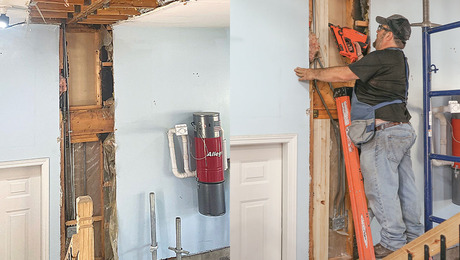Friend had a new fence installed in his yard and the fence guys clobbered one of his lawn sprinkler lines. He thinks the line is regular PVC, maybe 1″ maybe 3-4′ down.
Any suggestions on the best way to fix the line? He is in very close proximity to the new fence and is hoping that he doesn’t have to disassemble the new fence to get the repair done.
I told him PVC is easy to work with, but I wasn’t sure what the best way to approach this one was. Not like you can wiggle the PVC line back to fit on a new piece.
Ideas?
jt8
“A little ‘enthusiasm’ and all problems seems small!”















Replies
Get a shovel and start digging. It's an easy fix, may need to relocate the line if ran right through where they set the fence posts. Still not a big deal.
ML
I'd be surprised if it's that deep, sprinkler systems are usually only 6-12 inches deep, but PVC is cheap, fittings are cheap, it's mostly the labor to expose the damage and give yourself enough room to get in and splice it. Use a good, fresh primer and glue, dig a big enough hole so you have room to manuever. It's all labor.
As others have said, it's labor for digging.
Dig more hole than you need.
Why?
Length of your hand to your elbow is why. And sure as shooting, you'll need your hand and fore arm all the way in the hole.
If you don't have one, get a tarp or some visqueen (6mil polyethylene sheeting). Dump the dirt out on that, it makes it neater to clean up afterwards. Be ready for muddy and awful, too.
If you are hard up against the fence (Murphy likes that sort of thing) and you need to cut the pvc, get some fine cotton string handy. Take a loop around the pvc and pull back and forth, the heat will neatly cut through the pvc (and no sawing <yay!>).
Go ahead and expose the pipe first, if only so you'll know what's there. Having pvc unions is handy, but not if the piping was plow-pulled ABS or PE. This is also handy incase you need a short bit of pvc and a second union. (BTDT)
John,
There are some slip on expanding couplings and some like fernco with rubber gaskets.
I have fixed some 2" with 4 90º fittings and some short pieces. Made like an inverted u shape.
KK
Dig the bigazz hole for maneuvering room. Find out what size pipe. Use a slip-fix coupling (non compression) with solvent weld ends. Make sure to clean and primer very well. Use the correct glue too!
Quantum materiae materietur marmota monax si marmota monax materiam possit materiari?
Thanks for the replies. I'm copying all your responses and sending them to him. jt8
"A little 'enthusiasm' and all problems seems small!"
I just fixed a crack in my mom's lawn sprinkler system. This was in the supply line just before the solenoid valves. Everything was jammed together right next to the house, so cutting and replacing would have meant cutting and replacing several lines. The pvc pipe was 3/4", so I cut a short section of 1" pvc, cut it in half, coated the inside with something called "Plastic Welder", slapped that over the crack and held it on with hose clamps. After the recommended 24 hours, I turned the water back on and no more leaks. I bought but couldn't use the regular two piece repair sleeve because it was too long to fit between the various fittings.
john also tell him that at 3 - 4 feet down the most conscientious landscapers would run a real risk of tearing up ALL the utilities.... maybe even sewer lines.
.
.. . . . . . . .